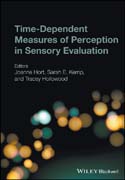
Time-Dependent Measures of Perception in Sensory Evaluation
Hort, Joanne
Kemp, Sarah
Hollowood, Tracey
Sensory evaluation is a scientific discipline used to evoke, measure, analyse and interpret responses to products perceived through the senses of sight, smell, touch, taste and hearing. It is used to reveal insights into the way in which sensory properties drive consumer acceptance and behaviour, and to design products that best deliver what the consumer wants. It is also used at a more fundamental level to provide a wider understanding of the mechanisms involved in sensory perception and consumer behaviour. Sensory perception of products alters considerably during the course of consumption/use. Special techniques are used in product development to measure these changes in order to optimise product delivery to consumers. Time–Dependent Measures of Perception in Sensory Evaluation explores the many facets of time–dependent perception including mastication and food breakdown, sensory–specific satiety and sensory memory. Both traditional and cutting–edge techniques and applications used to measure temporal changes in sensory perception over time are reviewed, and insights into the way in which sensory properties drive consumer acceptance and behaviour are provided. This book will be a valuable resource for sensory professionals working in academia and industry, including sensory scientists, practitioners, trainers and students; and industry–based researchers in QA/QC, R&D and marketing. INDICE: Notes on Authors, ix .List of Contributors, xi .Preface, xiii .Preface to the Series, xvi .Acknowledgements, xix .Section 1: Introduction .1 Time –dependent Measures of Perception: An Introduction, 3Joanne Hort, Tracey Hollowood and Sarah E. Kemp .Section 2: Physiological and psychological aspects of time –dependent sensory perception .2 Mastication, Salivation and their Interactions during Eating, 27Guy Carpenter and Annie Blissett .3 Sensory –specific Satiation and Satiety, 48Marion M. Hetherington, Samantha Caton and Chandani Nekitsing .4 Sensory Adaptation, 67Louise Hewson and Amparo Tarrega .5 Sensory Memory, 88Ep Köster and Jos Mojet .6 The Dynamics of Liking, 124Jos Mojet and Ep Köster .Section 3: Techniques .7 General Considerations, 159Erminio Monteleone and Caterina Dinnella .8 Time Intensity Using Discrete Time Points, 182Carla Kuesten .9 Continuous Time Intensity, 237Caroline Chaya .10 Dual–attribute Time intensity, 267Christopher J. Findlay .11 Temporal Dominance of Sensations, 283Pascal Schlich and Nicolas Pineau .12 Multiple–ingestion Time Intensity, 321Linda Jamieson and Emma Watling .Section 4: Applications .13 Application of Time –dependent Measures to Food Products, 345Nathalie Martin .14 Temporal Methods for the Assessment of Household and Personal Care Products, 362Tracey Sanderson and Tracey Hollowood .15 Application of Time–Dependent Measures to Understand Sensory Perception, 388Joanne Hort .Section 5: Summary .16 Summary, 401Joanne Hort, Tracey Hollowood and Sarah E. Kemp .Index, 000
- ISBN: 978-0-470-67138-2
- Editorial: Wiley–Blackwell
- Encuadernacion: Cartoné
- Páginas: 456
- Fecha Publicación: 30/12/2016
- Nº Volúmenes: 1
- Idioma: Inglés
